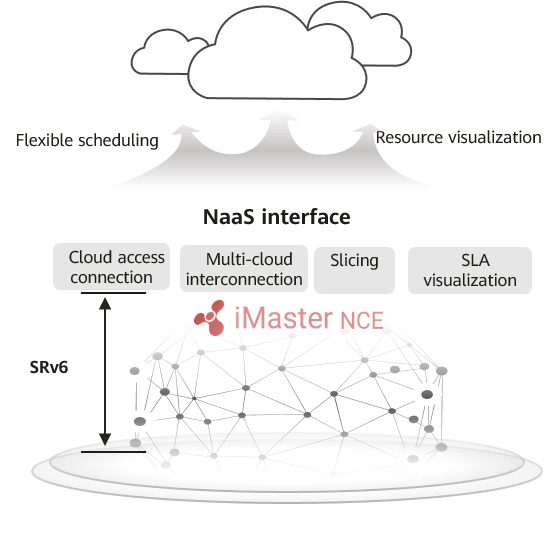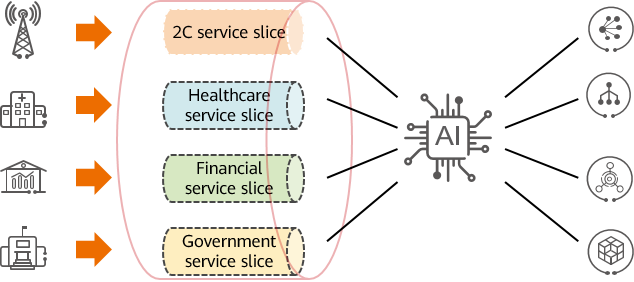What Is an Intelligent Cloud-Network?
A cloud-network is a network that connects and enables clouds. The intelligent cloud-network transfers tremendous intelligence and computing power to enterprises and individuals, instilling new impetus into the digital economy. The intelligent cloud-network, characterized by digitalization, intelligence, and servitization, provides intelligent connections for enterprise cloudification to accelerate the digital development of all industries.
Why Do We Need the Intelligent Cloud-Network?
The second industrial revolution was driven by the emergence of electric power technologies, with power grids transmitting power from power stations to industries and households. In the fourth industrial revolution, cloud is the core technology that produces computing power and intelligence. The intelligent cloud-network functions like the "power grid" in the digital economy era. It transfers tremendous intelligence and computing power to enterprises and individuals, instilling new impetus into the digital economy.
The intelligent cloud-network is characterized by digitalization, intelligence, and servitization. Digitalization enables the intelligent cloud-network to provide intelligent, service-oriented capabilities to better serve enterprise cloudification.

Three major characteristics of the intelligent cloud-network
Global digitalization is accelerating as digitalization technologies continue to advance. Fueled by national strategies and digital transformation trends, an increasing number of enterprises are migrating their services to the cloud. According to IDC, 80% of enterprises will accelerate their cloud migration by the end of 2021. For these enterprises, a multi-cloud access mode involving public, private, and hybrid clouds is the preferred choice. Moreover, production cloudification that imposes high requirements on networks will be the future development direction.

Cloudification trend
With cloud-driven industry transformation and accelerating enterprise cloudification, carrier cloud-networks face four major challenges.

Challenges facing carrier cloud-networks
Challenge 1: Fast on Cloud But Slow on Network (Cloud Access Within Minutes Is Required)
The cloud and network do not match in terms of service provisioning speed. While cloud service provisioning is fast due to the development of enterprise digitalization — such services can be subscribed in e-commerce mode and provisioned within minutes — network service provisioning is slow, taking months to establish a connection between the enterprise side and cloud side.
For example, data provided by a bank's information center indicates that it takes less than 1 hour to provision a cloud service but 33 days to provision a network service.
Challenge 2: Difficult Multi-cloud Access (Cloudification Requires One Connection to Multiple Clouds)
As key information systems and core production systems become cloudified, enterprises will use multi-cloud and hybrid cloud deployment modes due to concerns over aspects such as security, cost, and scalability. Currently, an enterprise that wants to access multiple clouds must purchase multiple cloud private lines, as one such line can be used to access only one cloud. Because enterprises need a globally reachable cloud access private network to conveniently provide cloud + network services, one-network-per-cloud services cannot meet enterprises' requirements.
Challenge 3: Difficult Experience Assurance (Cloudification Requires Deterministic Experience)
Cloudification of core enterprise services requires high bandwidth and low delay. Traditional QoS technologies cannot provide deterministic and visualized service experience or guarantee service SLAs. For example, consider a high-speed train: The one-way delay between the train and control point must be less than 10 ms to ensure rapid control of the train.
Challenge 4: Lack of Cloud-Network-Security Collaboration (Cloudification Requires Cloud-Network-Security Collaboration)
Service cloudification overcomes the boundaries of enterprise networks. Enterprise security needs to be transformed from single-point protection provided by firewalls to E2E integrated security between devices, networks, clouds, and applications.
Key Characteristics of the Intelligent Cloud-Network
To address the four major challenges facing traditional networks, the intelligent cloud-network provides four key features: network as a service (NaaS), flexible multi-cloud connection, deterministic experience, and cloud-network-security collaboration. These features help carriers build leading cloud-network convergence service capabilities.
- Network as a service (NaaS): cloud-network mutual scheduling, addressing the mismatch between the cloud and network
Currently, the cloud and network are separated, making cloud-network service provisioning and fault O&M both time- and labor-consuming and giving rise to difficult northbound integration. The intelligent cloud-network provides NaaS capabilities for enterprise users, offering the following advantages:
1. Fast service provisioning. The service rollout time is shortened from several days (industry average) to several minutes when resources are available. SRv6-based multi-domain service provisioning further facilitates cloud access and multi-cloud interconnection. The network controller provides one-click delivery of network slices and services.
2. Fast fault locating, facilitating network self-healing. SRv6 carries services in an E2E manner, eliminating network breakpoints. The network controller visualizes network resource SLAs and service SLAs, automatically demarcates and locates network faults, and locates the root causes of over 90% of faults within 5 minutes.
3. Network service-oriented interface design, facilitating northbound integration. Service APIs reduce integration complexity by about 90% by presenting hundreds of tenant-level parameters instead of thousands of network-level parameters. Network resources can be flexibly invoked through APIs, and resources can be easily visualized in the operations domain.
Advantages of NaaS - Flexible multi-cloud connection: one connection to multiple clouds, facilitating multi-cloud access
In the past, most enterprises had only limited cloudification requirements. Enterprises tend to deploy less important services, such as Internet applications, on the public cloud and deploy production systems on self-built private clouds. But with the deepening of enterprise IT informatization, various information systems and core production systems are being migrated to the public or industry cloud. In this phase, users in large and midsized enterprises and in industry sectors typically require multi-cloud access, giving rise to increasingly diverse enterprise cloudification scenarios. As specific cloudification scenarios continue to increase, multi-cloud or hybrid cloud have become a mandatory choice for most enterprises. The cloud PE on the cloud backbone network physically pre-connects to multiple clouds, allowing a user to flexibly access applications from different cloud service providers through one network carrier's cloud private line. The network PE on the cloud backbone network physically connects to multiple networks, enabling an enterprise to achieve one-network wide connection through only one service access point connected to the carrier network.
One connection to multiple clouds - Deterministic experience: critical service isolation, facilitating experience assurance
On a traditional IP network, links are shared, and bandwidth cannot be guaranteed. Furthermore, the network delay and jitter affect services. When a fault occurs on the network, the network can respond only passively, requiring manual intervention and an uncertain recovery time. The intelligent cloud-network uses new technologies such as slicing to isolate critical services, delivering private network-level service experience (guaranteed service bandwidth and network KPI performance) to users. Moreover, intelligent O&M ensures service quality. Proactive service O&M and real-time network KPI detection enable issues to be discovered before they affect services. The intelligent network controller can automatically rectify faults based on learning results.
Deterministic experience - Cloud-network-security collaboration: full coordination, ensuring collaboration among the cloud, network, and security
As increasingly more services are deployed on the cloud, users are paying greater attention to security issues related to cloud access. Security here covers not only cloud platform security, but also network security. In the past, network security focused on defending against attacks on network devices in single-point defense mode. Shifting focus, the intelligent cloud-network solution proposes cloud-network-security collaboration in terms of security policies. The general idea is that the network controller uses security policies to ensure the security of network infrastructure, and the cloud controller uses security policies to ensure the security of the cloud. A network-wide security situation awareness and processing platform is deployed to monitor the security of the cloud-network infrastructure and interwork with the network controller and cloud controller to ensure integrated cloud-network security. The network-wide security situation awareness and processing platform performs intelligent analysis to accurately locate security events, responds to security warnings within seconds, and quickly blocks threats at the source end, increasing the threat detection rate from 60% to 96%.
Cloud-network-security collaboration
Successful Application of the Intelligent Cloud-Network
Carriers
Carriers construct intelligent cloud-networks to secure advantages in terms of network resources. They integrate resources, such as their self-built clouds and cloud service providers' public clouds, to provide cloud-network coordinated services for enterprise users, expanding the business boundary of cloud-networks.
- Cloud backbone network
Carriers transform from providing only cloud access to providing multi-cloud services. They connect various clouds, including public, private, third-party, and industry clouds, through their cloud backbone network to achieve physical pre-connection between clouds and networks.
- Cloud metro network
Based on the service requirements of government and enterprise customers, the cloud metro network provides highly secure and high-quality slice-based private line networks between enterprises and clouds. With underlay-overlay collaboration on these slice-based private line networks, the cloud metro network enables one hop to multiple clouds and provides on-demand network SLA assurance to ensure service quality.
- Hyper-converged data center network
Intelligence is introduced to control the traffic rate, achieving zero packet loss within data centers and between intra-city active-active data centers (within 70 km of each other). Network-wide intelligent O&M enables minute-level fault detection and self-healing, ensuring 24/7 service availability.
- Network security
Working with Tianguan enterprise-side security gateways, the Huawei Qiankun® cloud service achieves a detection rate of 96% for new threats. Furthermore, it detects hidden attacks within minutes, blocks near-source threats related to cloud-network-security collaboration, implements cloud-based deployment of atomic security capabilities, and provides cloud-based O&M and security services in subscription mode.
Industry Users
The intelligent cloud-network has been applied to sectors such as government, healthcare, education, finance, mining, port, steel, and electric power.
- Government
The intelligent cloud-network solution for the government sector helps carrier A build a private network for government and enterprise services. This network provides intelligent connections for smart government applications by delivering network and fast cloud access services to over 1000 organizations, over 20,000 video surveillance terminals, and over 300,000 IoT terminals in the city.
- Healthcare
The intelligent cloud-network solution for the healthcare industry uses Huawei cloud terminals to provide rapid cloud access and inter-cloud interconnection services for healthcare organizations, helping carrier B provide cloud-network services for multiple healthcare organizations in the province. This solution meets the informatization reconstruction requirements of the regional healthcare industry, enables information sharing among regional medical alliances, and effectively supports the implementation of hierarchical diagnosis and treatment policies.
- Education
The intelligent cloud-network solution for the education industry provides capabilities such as security isolation on a multi-purpose network and fast cloud access, solves issues such as education resource imbalance and silos, enables education resource sharing, and reduces repeated investments.
- Power
The intelligent cloud-network solution for the power industry uses advanced technologies such as FlexE-based slicing, ultra-broadband Ethernet, and intelligent management and control to provide deterministic network experience for electric power users. It effectively promotes the digital transformation of power grids and helps electric power enterprises accelerate their transformation to the energy Internet era.
- Author: Chen Peishan
- Updated on: 2021-10-16
- Views: 3457
- Average rating:











